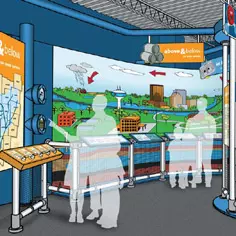
Environment and Biodiversity
Place
Dayton, Ohio, United States
Sponsor
James McDonald
Grant(s)
€20,000 to the Selection Committee at 2011/06/28
Project leader
Dayton Society of Natural History, DBA Boonshoft Museum of Discovery
"I am personally involved in this project and I want to share the message of water: it's an essential element at every instant of our lives, and a unique and fascinating molecule.We have to learn to protect and respect this resource, to communicate on the seriousness of the water trades, to generate curiosity about water, and to encourage people to learn: the show achieves all these objectives."
James McDonald
The Boonshoft Museum of Discovery of Dayton, whose story began in 1893, and which bears the name of one of the institution's greatest friends, welcomes nearly 200,000 visitors each year (including 35,000 school children).A traditional museum, it is also a museum for children, a museum of natural history, a zoo, a planetarium and an observatory.It is accredited by the American Association of Museums and the Association of Zoos and Aquariums (an NGO that guarantees the quality of life of animals in captivity and the preservation of the species in the world), affiliated with the Association of Children's Museums and director of Association of Science-Technology Centers.
An abundant and yet precious resource
Water is not a scarce resource in Ohio: Dayton stands one of the biggest and cleanest aquifers of the United States, providing nearly five million people with access to clean, pure water.Owing to this abundance, the population have never been aware of the negative impact that human and agricultural activities could have on water.The Boonshoft Museum wants to fill this gap while highlighting the water trades with the "Water Ways" exhibition, designed to demonstrate the link between human activity and water pollution, and thereby incite the visitors to civic and nonpollutant behavior.
The experience of the Museum of Discovery of Dayton in raising the awareness of young people has enabled it to develop an entertaining, educational itinerary over more than 100 square meters, aimed at families, around the water cycle, its various routes and wastewater treatment.The show also addresses the history of water in the region, returning in particular to the flood of 1913, which led to the evacuation of many families and the construction of dams; and to the ecological disaster of St. Mary's Lake, a leisure spot for many families, which has been closed since 2009 to recreational use because of agricultural pollution.The state of Ohio and the Dayton area have also suffered from the 2008 economic crisis: nearly half a million jobs were wiped out.Water is one of the area's major assets, and the museum also wants the exhibition to highlight the professional opportunities offered by the water trades.
Alongside private and public partners, like the city of Dayton and the Miami Conservation District, the Veolia Foundation is participating in financing this exhibition, which intelligently addresses the various aspects of sustainable development through a subject that is sensitive both locally and globally.

